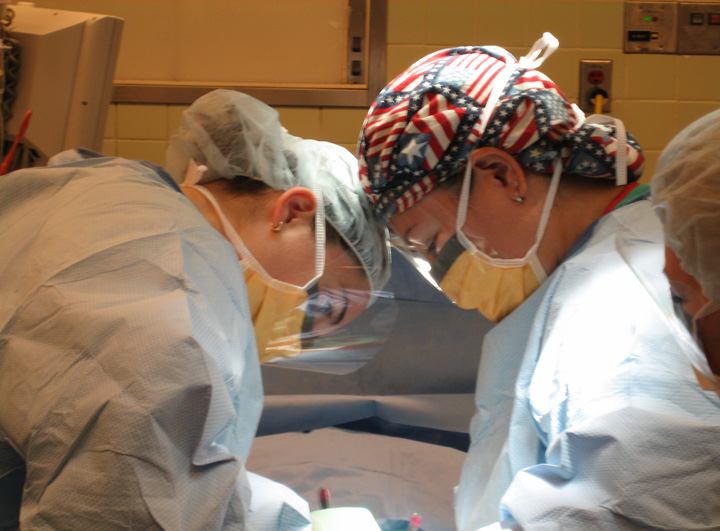Learn about how today’s leading hospitals are working with Surgical Affiliates to implement 24/7 emergency surgical care. As well as how these hospitals address the fears many local surgeons have about the program’s impact on the surgical volume and team structure.
To overcome the challenges inherent in standard surgical care models, hospitals require systematic approaches that offer effective solutions to reduce transfers out of the hospital, improve current standards of care, and increase the number of surgery cases performed without sacrificing care quality.
While a surgical hospitalist program is designed to address these issues, there are several legitimate fears and misconceptions regarding these programs that are often raised by hospital medical staff. When unaddressed, these fears may perpetuate the repetitive care cycle that’s inefficient, costly, and associated with a higher risk of post-surgical complications.
The issue is, how do hospitals keep local surgeons happy under a surgical hospitalist program like the one offered from Surgical Affiliates? Also, how do hospitals prevent surgeons from threatening to take their services elsewhere when another group of acute care and emergency/trauma surgeons comes in?
Addressing the Fears of a Surgical Program
Despite the benefits of the Surgical Affiliates approach, there are some legitimate fears associated with this type of program that often prevents adoption.
When a third-party surgical team comes in to cover acute care and emergency surgery services, many hospitals fear that local on-call surgeons will find their position within the center threatened, resulting in surgeons taking their services to another hospital. The local on-call surgeons often own private practices and typically receive a stipend for emergency coverage, which helps to supplement their income. The fear of losing this stipend can provoke anxiety among local surgeons. Of course, one of the main goals is to ensure these professionals are satisfied, as they are typically prime sources of revenue for the hospital.
It’s appropriate to be concerned that an outside program will produce resentment among medical staff and result in a loss of business from the current cadre of local providers. However, the data does not support the notion that surgicalist programs decrease business — in fact, these programs help satisfy local surgeons and increase surgery caseload.
Keep reading to learn how Surgical Affiliates accomplishes this in hospitals across the nation.
How a Surgical Program Increases Business for Local Surgeons
One of the issues many hospitals have concerning a program like Surgical Affiliates is that surgeons may feel their position will become minimized following adoption. Fortunately, this surgical solution works with local surgeons and provides them options related to how and when they wish to practice, essentially resulting in zero loss in the number of cases they can perform in any given shift.
In general, hospitals participating in a surgicalist model feature an equal mix of surgeons – some surgeons want to focus on elective cases, some want the option of elective and/or emergency cases, and some want to focus purely on emergency care. Under the program, these options are available for all currently employed surgeons at the facility. And, if surgeons don’t want to take a call, they don’t have to. This can help them focus more on the elective cases that they enjoy — however, emergency cases are still theirs for the taking if they require or want the extra income.
A Surgical Program Provides Cost-Effective Care Despite Initial Investment
Another barrier to program engagement includes the initial costs associated with implementing a “‘round-the-clock acute emergency care surgical program.” Despite these fears, all hospitals under the program see a return on investment (ROI), due to Surgical Affiliate’s expertise in creating efficiencies and the program’s ability to manage surgical opportunities that may have otherwise been transferred to outside centers.
Additionally, with a greater number of on-site surgeons available for emergency surgical services, even rural hospitals become a reliable source of care in the community. This improved community-wide trust increases the number of cases that come into the hospital, thereby affecting the hospital’s bottom line.
Surgical Affiliates: Case Studies
In a retrospective 5-year study of the Surgical Affiliates strategy implemented in Sutter General Hospital in Sacramento, California, none of the surgeons in the hospital experienced a loss of business and all performed just as many operations during the 5-year period as they performed prior to program adoption. During these 5 years, complications, length of hospital stay, readmissions, and hospital costs significantly decreased for emergency cases, following the implementation of the acute care surgical model.1
In fact, in every hospital that adopts the Surgical Affiliates program, emergency surgical volume steadily increases and the operative volume for local surgeons does not decline, despite all emergency operations being performed by the Surgical Affiliates team. NorthBay Medical Center in Fairfield, California, for instance, observed a 3.2% increase in the number of operations performed during a 2-year period. The center also observed an improvement in operating margins from a 3-year period of -2.1% in 2011 to .2% in 2012, and 6.3% in 2013.2
Learn More About Surgical Affiliates’ Surgical Program
Hospitals should present these findings to surgeons or other hospital personnel who may feel nervous about potential program adoption. Knowing the real-world data regarding how the program works and understanding how to communicate these findings to hospital staff may prevent surgeons from taking their elective surgical services elsewhere.
To learn more about the program offered by Surgical Affiliates and how it’s been successful for driving down hospital costs, reducing transfers and complication rates, and retaining and satisfying local surgeons, read through our case studies and take a look at our recent media stories demonstrating its effectiveness in today’s clinical setting.
References:
-
O’Mara MS, Scherer L, Wisner D, Owens LJ. Sustainability and success of the acute care surgery model in the nontrauma setting. J Am Coll Surg. 2014;219(1):90-98.
-
NorthBay Medical Center: Case Study. Surgical Affiliates data on file.




Latest posts